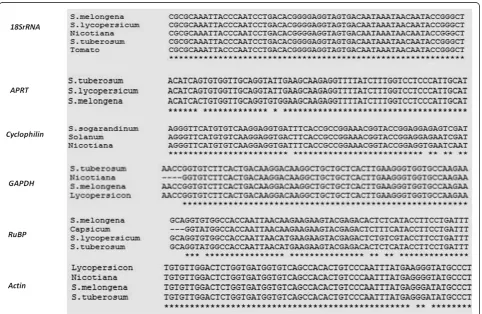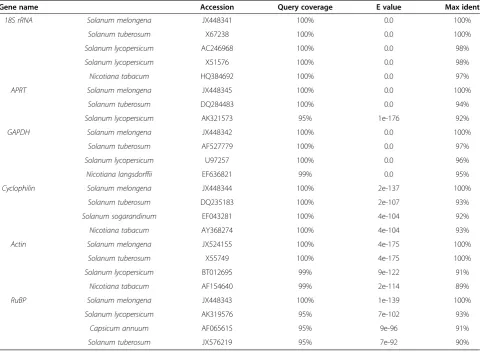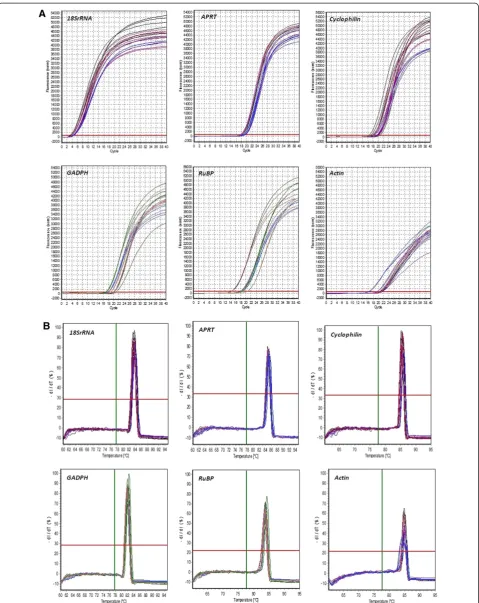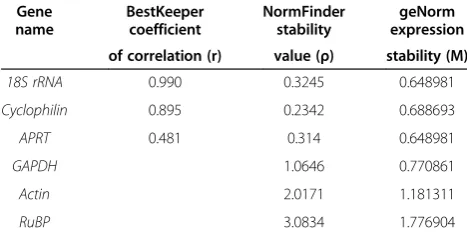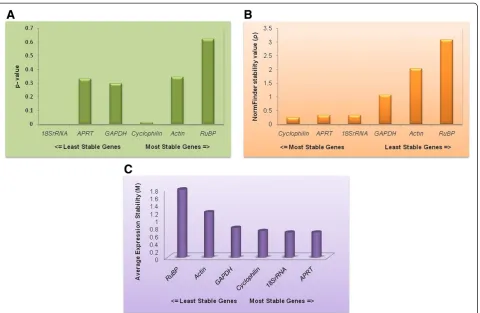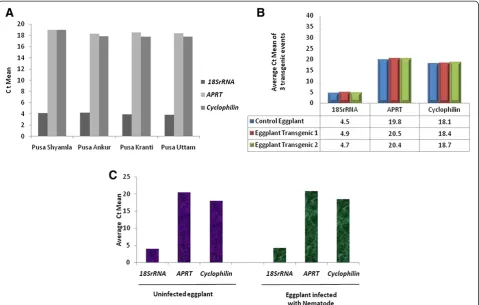R E S E A R C H A R T I C L E
Open Access
Selection and validation of reference genes for
quantitative gene expression studies by real-time
PCR in eggplant (Solanum melongena
L)
Nagavara Prasad Gantasala
1,2, Pradeep Kumar Papolu
1,2, Prasoon Kumar Thakur
1, Divya Kamaraju
1,
Rohini Sreevathsa
3and Uma Rao
1*Abstract
Background:Analysis of gene expression patterns leads to functional understanding of biological processes. Quantitative real-time PCR has become the most commonly used technique for in-depth studies of gene expression. To quantify variation in specific gene expression, accurate and reliable normalization across different samples and tissues is necessary. This can be achieved by selecting one or more suitable reference genes to compare the target mRNA transcript levels. In the present work, we illustrate the first evaluation of potential internal control or reference genes across different developmental stages of eggplant for reliable quantification of
transcripts by real-time PCR.
Results:We have evaluated the stability in expression of six candidate reference genes (18s rRNA, APRT, GAPDH, Cyclophilin, Actin, andRuBP) in a set of tissues representing six developmental stages of eggplant. The candidate genes were cloned from cDNA and analysed by real-time PCR. The expression data analyzed by three statistical methods (geNorm, NormFinder and BestKeeper) identified18s rRNA, CyclophilinandAPRTas the most stable and suitable reference genes in eggplant. This was further confirmed in four different varieties, two representative lines of transgenic eggplant as well as in nematode infected eggplant.
Conclusion:18s rRNA, CyclophilinandAPRThave been found to be appropriate for the normalization of real-time PCR data for gene expression studies in eggplant.
Keywords:Reference genes, Housekeeping genes, Eggplant (or) brinjal,Solanum melongena L, Quantitative real-time PCR (qRT-PCR), Normalization, Gene expression
Background
Gene expression analysis is an important tool to under-stand the functional aspect of genes. Quantification of the steady-state mRNA by real-time PCR is identified as the most reliable and commonly used approach for basic research, molecular medicine and biotechnology [1,2]. Gene expression levels are routinely evaluated using ap-proaches such as, northern hybridization and reverse transcription-polymerase chain reaction (RT-PCR). The possibility of high throughput analysis combined with its high sensitivity, reliable specificity and simplicity render
the real-time PCR approach as the most appropriate strat-egy [3-5]. However, the real-time PCR based approach can be dependable only when the results are normalized. The use of unreliable reference genes or internal control genes for normalization of the data is the major lacuna of this ap-proach [6,7]. Normalization is essential for correcting the errors that could arise due to inaccurate quantification of RNA and problems in the quality of RNA leading to vari-able reverse transcription and PCR reactions. Even though various strategies are employed to normalize qRT-PCR (quantitative-real time PCR), it still remains as one of the primary challenges in the utility of this technique [7]. A gene whose expression remains stable across tissues and developmental stages would represent the best system for normalization of the qRT-PCR data. The stability of such * Correspondence:umarao@iari.res.in
1
Division of Nematology, Indian Agricultural Research Institute, New Delhi 110012, India
Full list of author information is available at the end of the article
reference genes across genotypes of a particular crop spe-cies would be an added advantage.
Some of the house keeping genes involved in basic cellu-lar activities such as18s rRNA,25s rRNA, glyceraldehyde-3-phosphate dehydrogenase (GAPDH) and ubiquitin (UBQ) are some of the commonly used internal control genes as they are likely to be expressed at constant levels regardless of experimental conditions [8-12]. However, re-cent studies suggested that expression of these genes vary significantly under different environmental conditions [6,13,14]. Therefore, it is necessary to identify the internal control gene (s) for the efficient quantification of a target mRNA by qRT-PCR in a given set of biological samples. Several statistical algorithms such as geNorm, BestKeeper and NormFinder have been developed to determine the stability of reference genes in a given set of biological sam-ples [15,16]. Several studies have used these programs for the evaluation of various housekeeping genes to establish their utility as reference genes for normalization of real-time PCR data in various plants [8,14,17-20].
Eggplant popularly known as Brinjal in India, is an agronomically important non-tuberous Solanaceous crop primarily grown for its large oval fruit. In addition to being a popular vegetable, it has therapeutic value and
used for the treatment of several diseases such as diabetes, arthritis, asthma and bronchitis [21]. It can be a good alter-nate model plant for studying various agronomic traits through transgenic technology because of its high response to in vitro regeneration leading to high genetic trans-formation efficiency [22]. Genomics efforts have lead to the accumulation of approximately 98,089 ESTs in egg-plant (NCBI dbEST) which can be an excellent source for prospecting novel genes and deciphering their biological functions. However, gene expression analysis by qRT-PCR is limited in eggplant primarily due to the lack of informa-tion about genes which can serve as internal controls. In this context, the present study was undertaken to select and validate the most suitable internal control gene(s) in eggplant for effective normalization of the qRT-PCR data.
Results
Cloning of the reference genes from cDNA of eggplant PCR amplification of six target reference genes viz.,18s
rRNA, APRT, GAPDH, Cyclophilin, Actin, RuBP from
[image:2.595.57.541.398.664.2]the cDNA resulted in 416 bp, 454 bp, 586 bp, 265 bp, 333 bp, and 269 bp amplicons respectively, which were cloned and sequenced (Figure 1A & 1B). Moreover com-parative analysis of the sequenced products revealed high
Figure 1Amplification of the housekeeping genes and confirmation of cloning byEcoRIdigestion of pGEM-T vector. (A)Amplification of the six target genes from cDNA of eggplant Lanes - M: 100 bp DNA Ladder/Marker, 1.18S rRNA(416bp), 2:APRT(454 bp), 3:GAPDH
(586bp), 4:Cyclophilin(265 bp), 5:Actin(333 bp), 6:RuBP(269bp).(B)Confirmation of the inserts in the recombinant pGEM-T vector byEcoRI
(95-100%) similarity with the members of Solanaceae family (Figure 2 &Table 1). The sequences were later de-posited in the GenBank database (GenBank: JX448341, JX448342, JX448343, JX448344, JX448345, JX524155). In order to check the presence of introns between the pri-mer binding sites, all the six reference genes were PCR amplified from the genomic DNA extracted from the eggplant leaves (Figure 1C). Except forAPRT, amplifica-tion was successful for all the other five genes. There was no amplification in APRT probably due to the presence of a big intronic region; in case ofGAPDH, the amplicon was bigger than the cDNA fragment indicating the pres-ence of an intron. With respect to the other four genes, the size of the genomic DNA fragments was same as that of the cDNA fragments.
Assessment of expression stability of reference genes Genes encoding for 18s rRNA, adenine phosphori-bosyl transferase (APRT), glyceraldehyde 3-phosphate dehydrogenase (GAPDH),Cyclophilin,Actin, Ribulose-1,5-bisphosphate carboxylase (RuBP) were selected based on previous studies that relied on them as candidate reference genes [23-25]. In order to calculate the stability of expres-sion of the selected six candidate reference genes, mRNA
expression levels were measured in six different tissues of the eggplant (young leaf, mature leaf, shoot, root, flower bud and open flower). Ct mean values of three biological replicates were obtained from Realplex2software. These Ct mean values were further used for the calculation of ex-pression stability (Figure 3A & 3B, Table 2). Real-time PCR analysis revealed a large significant similarity in the ob-served expression pattern of all the genes across various tissues. Three commonly used statistical algorithms viz., BestKeeper, Normfinder and geNorm were employed for normalization of expression pattern and to validate Ct values for choosing the best reference genes.
Best keeper analysis
[image:3.595.58.541.400.714.2]This analysis was done using the raw Ct values. Initially, variations (SD (± Ct) and CV (%Ct)) were calculated for each of the candidate reference genes in the samples for identifying the overall stability in gene expression. Three candidate reference genes (GAPDH, Actin and RuBP) showed an SD value higher than 1, which disqualified their utility as reference genes. Remaining three genes were selected for further analysis as they showed SD value less than 1. Further processing of the data using pair wise correlation and regression analysis showed the
inter gene relations and eliminatedAPRT, as the gene with the least correlation (r = 0.481) (Table 3). The analysis of the remaining two genes (18s rRNA and Cyclophilin) showed a strong and significant correlation with an ‘r’ value of 0.990 for18S rRNAand 0.895 forCyclophilin in-dicating their stable expression levels. Accordingly, the BestKeeper index (p) was found to be 0.001 and 0.016 re-spectively for 18s rRNA and Cyclophilin(Figure 4A). In view of high correlation value and low BestKeeper index, 18s rRNAandCyclophilinwere selected as the two likely reference genes.
NormFinder analysis
NormFinder analysis results revealed that the gene ex-pression of three candidate reference genes,Cyclophilin, APRTand 18SrRNAhad lower stability values across the six tissue samples (Table 3). Further, manual inspection of the remaining reference genes showed that GAPDH ranked at the fourth position, had higher intra-group variation than 18s rRNA. Nevertheless, Actin and RuBP had highest intra-group variation and highest stability values. Thus, based on NormFinder analysis,Cyclophilin,
APRTand 18s rRNA were identified as the best candi-date reference genes (Figure 4B).
geNorm analysis
Analysis of raw non-normalized data of six different tis-sue samples (n = 6) allowed sorting of genes ranked on the basis of their expression stability (M) from most stable to least stable in the order of APRT, 18s rRNA, Cyclophilin, GAPDH, Actin and RuBP. Their calculated ‘M’ values were 0.648981, 0.648981, 0.68869, 0.770861, 1.18131 and 1.77690 respectively (Table 3, Figure 4C). Eventually, successive elimination of the least stable genes based on the highest‘M’values led to the identifi-cation ofAPRTand18s rRNAas the two potential refer-ence genes.
Therefore, based on the elaborate statistical analysis 18s rRNA, APRTand Cyclophilinwere identified as ap-propriate reference genes.
Validation of reference genes
[image:4.595.58.542.100.452.2]The selected genes were analyzed under various situa-tions to assess their utility to serve as reference genes: Table 1 BLAST analysis of the reference gene sequences
Gene name Accession Query coverage E value Max ident
18S rRNA Solanum melongena JX448341 100% 0.0 100%
Solanum tuberosum X67238 100% 0.0 100%
Solanum lycopersicum AC246968 100% 0.0 98%
Solanum lycopersicum X51576 100% 0.0 98%
Nicotiana tabacum HQ384692 100% 0.0 97%
APRT Solanum melongena JX448345 100% 0.0 100%
Solanum tuberosum DQ284483 100% 0.0 94%
Solanum lycopersicum AK321573 95% 1e-176 92%
GAPDH Solanum melongena JX448342 100% 0.0 100%
Solanum tuberosum AF527779 100% 0.0 97%
Solanum lycopersicum U97257 100% 0.0 96%
Nicotiana langsdorffii EF636821 99% 0.0 95%
Cyclophilin Solanum melongena JX448344 100% 2e-137 100%
Solanum tuberosum DQ235183 100% 2e-107 93%
Solanum sogarandinum EF043281 100% 4e-104 92%
Nicotiana tabacum AY368274 100% 4e-104 93%
Actin Solanum melongena JX524155 100% 4e-175 100%
Solanum tuberosum X55749 100% 4e-175 100%
Solanum lycopersicum BT012695 99% 9e-122 91%
Nicotiana tabacum AF154640 99% 2e-114 89%
RuBP Solanum melongena JX448343 100% 1e-139 100%
Solanum lycopersicum AK319576 95% 7e-102 93%
Capsicum annuum AF065615 95% 9e-96 91%
Varietal influence on the expression of identified genes
The utility of the identified genes was further analyzed in four different eggplant varieties using real-time PCR (Table 4). An expression pattern of high similarity was observed in all the four genotypes with every selected gene. This demonstrated the utility of the selected genes as reference genes for real-time PCR analysis in eggplant (Figure 5A).
Utility of the identified genes in transgene expression analysis
Further to the validation of the selected genes in differ-ent eggplant varieties, their utility was also established in the analysis of transgenics (Table 5, Figure 5B). The ref-erence genes play a vital role in the expression analysis of the transgenics using real-time PCR. Real-time ana-lysis of two representative transgenic lines revealed simi-lar expression pattern of all the three housekeeping genes.
Expression analysis of the identified genes in eggplant under nematode stress
The expression of the selected reference genes was also validated in the plants that were challenged with root knot nematodes (Meloidogyne incognita) (Table 6, Figure 5C). It was observed that the expression of the three reference genes in the leaf tissue of the nematode challenged plants was similar to that of the uninfected plants.
These above analyses ultimately confirmed the identifi-cation and utility of the three housekeeping genes as the appropriate reference genes for qRT-PCR analysis of gene expression in eggplant.
Discussion
[image:6.595.59.540.102.211.2]Gene expression profile studies provide an important insight into the biological processes of plant molecular biology research, hence are recognized as crucial steps in identifying gene function. Among the various tech-niques available to quantify gene expression, qRT-PCR is the most commonly used method [26-28]. It is the only sensitive technique available to measure the quantity of low abundance proteins [7,13]. However, to get de-pendable results from real-time PCR analysis, accurate normalization of gene expression against a reference gene is required. The reference gene should have stable expression independent of the experimental conditions, developmental stages, tissues etc. However, it is very diffi-cult to get a single gene that can qualify to be an ideal reference gene for gene expression analysis. Inappropri-ate use of reference genes would lead to a biased gene ex-pression analysis. Hence, an appropriate internal control gene is required for reliable quantification of gene tran-scripts [26]. Further, there is a need to identify and also confirm them for a given plant species as the reference genes authenticated in one organism or plant or a bio-logical system may not be suitable for gene expression analysis in another plant. For example, UBQ10 gene shows highly stable expression inArabidopsis[8], but is not suitable for normalization in different tissues at dif-ferent developmental stages in rice and soybean [25,29]. So far, such validated reference or internal control genes have not been reported in eggplant which could pose a limitation for undertaking gene expression studies in this important species. The primary focus of the present study was to identify and validate internal control genes from eggplant that can be used for normalizing the qRT-PCR data. In this direction, six housekeeping genes viz., 18s rRNA, APRT, GAPDH, Cyclophilin, Actin and RuBP were selected and their expression examined across six de-velopmental stages of eggplant variety, Pusa Purple Long. Table 2 Expression pattern of the reference genes in different tissues of eggplant
Cq ± SD
Plant tissue 18S rRNA APRT GAPDH Cyclophilin Actin RuBP
Young leaf 4.26 ± 0.26 19.16 ± 0.05 20.19 ± 0.61 19.95 ± 0.66 20.85 ± 0.48 15.03 ± 0.27
Mature leaf 4.16 ± 0.05 19.17 ± 0.23 19.73 ± 0.07 20.95 ± 0.19 21.16 ± 0.43 14.77 ± 0.09
Shoot 4.41 ± 0.06 18.11 ± 0.05 17.91 ± 0.05 21.95 ± 0.27 20.99 ± 0.49 18.47 ± 0.31
Root 4.35 ± 0.20 17.91 ± 0.04 17.65 ± 0.04 22.95 ± 0.48 21.18 ± 0.20 18.93 ± 0.12
Flower bud 3.35 ± 0.13 17.52 ± 0.03 16.80 ± 0.02 23.95 ± 0.69 19.57 ± 0.09 18.17 ± 0.29
Open flower 3.80 ± 0.03 18.69 ± 0.15 18.69 ± 0.11 24.95 ± 0.16 16.37 ± 0.17 21.11 ± 0.45
Table 3 Statistical analysis of the expression data of six housekeeping genes
Gene name
BestKeeper coefficient
NormFinder stability
geNorm expression
of correlation (r) value (ρ) stability (M)
18S rRNA 0.990 0.3245 0.648981
Cyclophilin 0.895 0.2342 0.688693
APRT 0.481 0.314 0.648981
GAPDH 1.0646 0.770861
Actin 2.0171 1.181311
[image:6.595.56.290.614.732.2]In order to minimize bias introduced by the validation ap-proach, the results were analyzed by three different com-plementary statistical strategies to select best internal controls for normalization of gene expression studies. Best keeper selects the least variable gene using the geometric mean of the raw data [15]. NormFinder not only measures the variation but also ranks the potential reference genes by how they differ between the studies [2] and geNorm al-lows the most appropriate mean of the expression of the candidate cDNA [25]. Using the three standard statistical analyses, 18s rRNA, APRTand Cyclophilin were identi-fied as appropriate genes for normalization. Nevertheless,
earlier studies revealed that the expression of both 18s rRNA and Cyclophilin were affected by both biotic and abiotic stress in potato [23]. On the other hand, 18s rRNA exhibited most stable expression in plants grown under various environmental conditions in rice [25]. Interestingly, GAPDH was found to be a suitable refer-ence gene for measuring the gene expression in different tissues/organs of sugarcane [30]. A report in Brassica
juncea [31] revealed the combination of GAPDH with
three other genes as suitable reference genes across differ-ent developmdiffer-ental stages.
Major crux of the investigation was to demonstrate the utility of the identified genes for expression analysis under different experimental conditions. The study successfully provided evidence in establishing stable expression of the identified genes across different eggplant varieties. The ex-pression of the genes was stable in different transgenic plants and also under biotic stress deliberately induced by challenging with nematodes. This provided an unequivocal evidence for the utility of these identified genes for expres-sion analysis by qRT-PCR in eggplant.
Conclusion
[image:7.595.60.541.87.400.2]We have cloned, sequenced and identified three genes viz.,18s rRNA, APRTandCyclophilinas reference genes Figure 4Expression stability and ranking of housekeeping genes by three statistical softwares, (A) Best keeper (B) NormFinder (C) geNorm.
Table 4 Confirmation of the stability of the identified reference genes in four different varieties of eggplant
Cq ± SD
Name of variety 18S rRNA* APRT* Cyclophilin*
Pusa Shyamla 4.15 ± 0.14 18.99 ± 0.24 19.04 ± 0.40
Pusa Ankur 4.24 ± 0.02 18.36 ± 0.01 17.86 ± 0.12
Pusa Kranti 3.95 ± 0.01 18.55 ± 0.03 17.78 ± 0.00
Pusa Uttam 3.88 ± 0.01 18.38 ± 0.00 17.80 ± 0.04
[image:7.595.57.292.628.707.2]in eggplant, suitable for normalizing real-time PCR data. This is the first study to identify the appropriate refer-ence genes in eggplant. With the growing genomic re-sources in eggplant, these genes would enable accurate and reliable gene expression data analysis over a wide range of samples/experimental conditions for functional genomics as well as in translational research.
Methods
Plant material and growth conditions
Eggplant seeds (CV. Pusa Purple Long) were procured from National Seeds Corporation Limited, Indian Agri-cultural Research Institute (IARI), New Delhi. Seeds were germinated and plants were grown under controlled con-ditions. Young leaves, stems and roots were collected for
analysis at 20 days, while flower buds, open flowers and mature leaves were collected after 45–50 days. Three independent biological replicates were collected for each of the samples and immediately frozen in li-quid nitrogen.
Primers
[image:8.595.59.539.89.394.2] [image:8.595.54.291.663.734.2]Nucleotide sequences of six housekeeping genes; 18s rRNA, adenine phosphoribosyl transferase (APRT), glyceral-dehyde 3-phosphate dehydrogenase (GAPDH),Cyclophilin, Actin and Ribulose-1,5-bisphosphate carboxylase (RuBP) were obtained from the GenBank database. Using primer quest tool in Integrated DNA Technology website, primers were designed for these sequences to be used in real-time PCR (200 bp maximum length, optimal Tm at 60°C, GC content of 45-50%). Details of the genes and their primers Figure 5Validation of reference genes (A) Validation in other eggplant varieties (B) Validation in transgenic eggplant (C) Validation in the presence of nematode stress.
Table 5 Confirmation of expression stability of the reference genes in representative transgenic eggplants
Cq ± SD
Plants 18S rRNA APRT Cyclophilin
Control 4.50 ± 0.25 19.80 ± 0.20 18.10 ± 0.30
Transgenic1 4.91 ± 0.16 20.50 ± 0.23 18.47 ± 0.14
Transgenic 2 4.72 ± 0.15 20.48 ± 0.14 18.78 ± 0.20
Table 6 Confirmation of expression stability of the reference genes in nematode infected eggplants
Cq ± SD
Plants 18S rRNA APRT Cyclophilin
Control 4.05 ± 0.10 20.42 ± 0.30 18.05 ± 0.17
[image:8.595.305.540.680.734.2]for both cDNA amplification and quantification by real-time PCR are given in Tables 7 and 8 respectively.
DNA isolation
Young leaves of one month old plants were ground in li-quid nitrogen and genomic DNA was extracted by using NucleoSpin plant II kit (Macherey-Nagel). The genomic DNA was quantified by using Nanodrop ND-1000 spec-trophotometer (Thermo Scientific) and used for PCR.
RNA isolation, quality controls and cDNA synthesis Total RNA was extracted initially from the leaves for cloning the target genes and subsequently from various other plant tissues like young leaf, mature leaf, root, shoot, flower bud and open flower using Spectrum Plant Total RNA Kit (Sigma-Aldrich). The quality and con-centration of each of the RNA samples was determined using Nanodrop ND-1000 spectrophotometer (Thermo Scientific), Bioanalyzer (Agilent 2100). Only those RNA samples having a ratio of 1.9 to 2.1 at 260/280; 2.0 to 2.5 at 260/230 and RIN (RNA integrity number) more than 7.0 were used for the analysis. The integrity of RNA was also checked by agarose gel electrophoresis. About 500 ng of each of the RNA was reverse transcribed using cDNA synthesis Kit (Superscript VILO, Invitrogen) according to the manufacturer’s instructions and used for further analysis.
Cloning and sequencing of the housekeeping genes 18s rRNA, APRT, GAPDH,Cyclophilin, Actin andRuBP were PCR amplified from both the genomic DNA and cDNA of eggplant leaf; PCR amplification reactions were
performed in 50μlreaction volume containing 5μl10 x assay buffer, 200 μM each of dATP, dCTP, dGTP and dTTP (Fermentas), 0.5 μM each primer (Table 7), 0.5-2 units of Taq polymerase (Sigma-Aldrich) and 1 μl gen-omic DNA (50 ng)/cDNA. The PCR cycles consisted of initial denaturation at 94°C for 4 min, followed by 35 cy-cles of denaturation at 94°C for 60 s, annealing at 60°C for 30 s and extension at 72°C for 1 min with a final exten-sion at 72°C for 10 min. The amplified products were later resolved on 1.2% agarose gel.
The amplified cDNA PCR products were cloned into pGEM-T Easy cloning vector (Promega) according to the manufacturer’s instructions. Freshly prepared com-petent cells of Escherichia coli DH5α were transformed with the recombinant plasmids. Positive clones were se-lected by blue white colony screening. Inserts in the clones were confirmed by restriction digestion withEcoRIand se-quenced by ABI solid sequencing platform (Safelab).
Real-time PCR
[image:9.595.55.540.100.199.2]Quantitative Real-time PCR (qRT-PCR) was performed using SYBR Green I technology in Realplex2thermal cy-cler (Eppendorf ). A master mix for each sample was pre-pared with SYBR Green I, blue dye, ROX passive reference and stabilizers, PCR Core Reagents (Eurogentec). Reaction mix of 10μlwas prepared by adding 2.5ngof cDNA and 750nMeach of the specific primers (Table 8). The amplifi-cation reactions were carried out at 95°C for 5 min, 40 cycles at 95°C for 15 seconds followed by 60°C for 1 min in qPCR high profile non skirted white 96-well plate (Eurogentec). Specificity of amplification was assessed by disassociation or melt curve analysis at 60-95°C after 40 Table 7 Details of primers used for the cDNA amplification of six candidate reference genes
Name Accession number Forward primer 5′-3′ Reverse primer 5′-3′ Length (bp) Tm(°C)
18S rRNA X67238 CGCGCAAATTACCCAATCCTGACA TCCCGAAGGCCAACGTAAATAGGA 416 60
APRT CK270447 TGGCGCCTCATGATCCGATTCTTA ACTCCAACACGCTCAAGAAGCCTA 454 60
GAPDH U17005 AACCGGTGTCTTCACTGACAAGGA GCTTGACCTGCTGTCACCAACAAA 586 60
Cyclophilin AF126551 AGGGTTCATGTGTCAAGGAGGTGA TCCAACAGCCTCGGCCTTCTTAAT 265 60
Actin X55749 TGTGTTGGACTCTGGTGATGGTGT AATAGGACCTCAGGGCAACGGAAT 333 60
RuBP FS083182 GCAGGTGTGGCCACCAATTAACAA TGCACTCTCCGACCTCATTCAACA 269 60
Table 8 Primers used for real-time PCR expression analysis of six candidate reference genes
Name Forward primer 5′-3′ Reverse primer 5′-3′ Length (bp) Tm (°C)
18S rRNA CGCGCGCTACACTGATGTATTCAA TACAAAGGGCAGGGACGTAGTCAA 172 60
APRT GAGATGCATGTAGGTGCTGTGCAA GGCCCTTCAATTCTGGCAACTCAA 163 60
GAPDH ATGGCCTTCAGAGTACCAACTGCT GCTTGACCTGCTGTCACCAACAAA 189 60
Cyclophilin GCGCCAAATTCAAGGACGAGAACT ACAGCCTCGGCCTTCTTAATCACA 196 60
Actin TGTGTTGGACTCTGGTGATGGTGT TCACATCCCTGACGATTTCTCGCT 185 60
[image:9.595.56.540.634.733.2]cycles. Real time PCR analysis was carried out for three biological replicates for each sample and three technical replicates were analyzed for each biological replicate.
Analysis of gene expression stability
Three statistical softwares; BestKeeper, NormFinder and geNorm were used for measurement of stability of expression of the six candidate genes.
BestKeeper analysis
BestKeeper computed the gene expression variation for the six reference genes in all the samples based on cross-ing points (CP) [32]. Primary analysis of the qRT-PCR data based on the assessment of raw CP values calcu-lated the standard deviation, SD (± CP) and coefficient of variance, CV (% CP) for the target genes in all the samples. This data was further used to determine the stability of gene expression. Based on the variability, control genes were ranked as the most stably expressed showing lowest variation to the least stable one with the highest variation. All the reference genes showing stable expression were combined into BestKeeper index for the individual sample using the geometric mean of the CP values for each of the candidate gene [15]. Samples with efficiency corrected intrinsic variation within three fold over or under expression were considered acceptable.
NormFinder analysis
NormFinder utilizes a model based approach to establish expression stability of candidate reference genes. It uses raw data as an input in the form of expression values gen-erated using the comparative Ct method. It estimates the overall expression variation of the candidate reference genes and the variation between sample subgroups [33].
geNorm analysis
The geNorm was used to calculate candidate reference gene stability values (M) using raw expression data. Ex-pression stability measure is calculated as the mean of pairwise variation of a gene compared to that of all other genes [34].
Validation of expression of the identified reference genes
In other eggplant varieties
Seeds of four popular eggplant varieties, Pusa Shyamla, Pusa Ankur, Pusa Kranti and Pusa Uttam were procured from Division of Vegetable Science, Indian Agricultural Research Institute, New Delhi. Total RNA was extracted from 15 days old seedlings and used for cDNA synthesis, followed by expression analysis.
In transgenic eggplant
The selected genes were also validated in randomly se-lected lines of transgenic eggplant using the leaf tissue
and compared with the wild type. Total RNA extracted from the leaf samples of transgenic plants was used for qRT-PCR.
Nematode infected eggplant
The shortlisted reference genes were also validated in nematode (Meloidogyne incognita) challenged eggplants. The roots of 15 days old plants were inoculated with ap-proximately 300 freshly hatched infective second stage ju-veniles of M. incognita. The nematode inoculated plants were grown in a growth chamber at 27°C, 70% relative hu-midity and 16 hr light and 8 hr dark conditions for 30 days for the nematode to complete its lifecycle. Subsequently, the leaves were used for real time PCR to study the expres-sion of the selected genes.
Competing interest
The authors declare that they have no competing interest.
Authors’contributions
UR conceived and designed the experiments and contributed in the manuscript preparation. NPG performed the qRT-PCR, statistical data analysis and preparation of the manuscript. PP carried out the cloning of
housekeeping genes and helped in script editing. PKT performed the statistical analysis and wrote the script. DK generated the transgenic and the nematode infected eggplant material. RS improved and carted the script. All authors read and approved the final manuscript.
Acknowledgement
We would like to acknowledge and extend our gratitude to Department of Biotechnology, Government of India for financial support and IARI, ICAR, New Delhi, India for infrastructure facilities and SRM University, Chennai, India. Special thanks to Dr. P. A. Kumar, Dr. M. Parani, Dr. M.S. Sheshshayee, Mr. Mukesh Kumar and Mr. Purshotam.
Author details
1Division of Nematology, Indian Agricultural Research Institute, New Delhi
110012, India.2Department of Genetic Engineering, SRM University, Chennai,
India.3National Research Centre for Plant Biotechnology, IARI, Pusa Campus,
New Delhi, India.
Received: 18 January 2013 Accepted: 29 July 2013 Published: 6 August 2013
References
1. Jain M, Kaur N, Garg R, Thakur JK, Tyagi AK, Khurana JP:Structure and expression analysis of early auxin-responsive Aux/IAA gene family in rice (Oryza sativa).Funct Integr Genomics2006,6(1):47–59.
2. Chuaqui RF, Bonner RF, Best CJ, Gillespie JW, Flaig MJ, Hewitt SM, Phillips JL, Krizman DB, Tangrea MA, Ahram M,et al:Post-analysis follow-up and validation of microarray experiments.Nat Genet2002,32(Suppl):509–514. 3. Bustin SA:Quantification of mRNA using real-time reverse transcription
PCR (RT-PCR): trends and problems.J Mol Endocrinol2002,29(1):23–39. 4. Gachon C, Mingam A, Charrier B:Real-time PCR: what relevance to plant
studies?J Exp Bot2004,55(402):1445–1454.
5. Giulietti A, Overbergh L, Valckx D, Decallonne B, Bouillon R, Mathieu C:An overview of real-time quantitative PCR: applications to quantify cytokine gene expression.Methods2001,25(4):386–401.
6. Thellin O, Zorzi W, Lakaye B, De-Borman B, Coumans B, Hennen G, Grisar T, Igout A, Heinen E:Housekeeping genes as internal standards: use and limits.J Biotechnol1999,75(2–3):291–295.
7. Huggett J, Dheda K, Bustin S, Zumla A:Real-time RT-PCR normalisation; strategies and considerations.Genes Immun2005,6(4):279–284. 8. Czechowski T, Stitt M, Altmann T, Udvardi MK, Scheible WR:Genome-wide
9. Bezier A, Lambert B, Baillieul F:Cloning of a grapevine Botrytis-responsive gene that has homology to the tobacco hypersensitivity-related hsr203J.
J Exp Bot2002,53(378):2279–2280.
10. Burleigh SH:Relative quantitative RT-PCR to study the expression of plant nutrient transporters in arbuscular mycorrhizas.Plant sci : an int j exp plant biol2001,160(5):899–904.
11. Foss DL, Baarsch MJ, Murtaugh MP:Regulation of hypoxanthine phosphoribosyltransferase, glyceraldehyde-3-phosphate dehydrogenase and beta-actin mRNA expression in porcine immune cells and tissues.
Anim Biotechnol1998,9(1):67–78.
12. Schmittgen TD, Zakrajsek BA:Effect of experimental treatment on housekeeping gene expression: validation by real-time, quantitative RT-PCR.J Biochem Biophys Methods2000,46(1–2):69–81.
13. Suzuki T, Higgins PJ, Crawford DR:Control selection for RNA quantitation.
Biotechniques2000,29(2):332–337.
14. Lee PD, Sladek R, Greenwood CM, Hudson TJ:Control genes and variability: absence of ubiquitous reference transcripts in diverse mammalian expression studies.Genome Res2002,12(2):292–297. 15. Pfaffl MW, Tichopad A, Prgomet C, Neuvians TP:Determination of stable
housekeeping genes, differentially regulated target genes and sample integrity: BestKeeper–Excel-based tool using pair-wise correlations.
Biotechnol Lett2004,26(6):509–515.
16. Hellemans J, Mortier G, De-Paepe A, Speleman F, Vandesompele J:qBase relative quantification framework and software for management and automated analysis of real-time quantitative PCR data.Genome Biol2007, 8(2):R19.
17. Vande-sompele J, De-Preter K, Pattyn F, Poppe B, Van-Roy N, De-Paepe A, Speleman F:Accurate normalization of real-time quantitative RT-PCR data by geometric averaging of multiple internal control genes.
Genome Biol2002,3(7). RESEARCH0034.
18. Goidin D, Mamessier A, Staquet MJ, Schmitt D, Berthier-Vergnes O: Ribosomal 18S RNA prevails over glyceraldehyde-3-phosphate dehydrogenase and beta-actin genes as internal standard for quantitative comparison of mRNA levels in invasive and noninvasive human melanoma cell subpopulations.Anal Biochem2001,295(1):17–21.
19. Brunner AM, Yakovlev IA, Strauss SH:Validating internal controls for quantitative plant gene expression studies.BMC Plant Biol2004,4:14. 20. Dheda K, Huggett JF, Bustin SA, Johnson MA, Rook G, Zumla A:Validation
of housekeeping genes for normalizing RNA expression in real-time PCR.
Biotechniques2004,37(1):112–114. 116, 118–119.
21. Franklin G, Sheeba CJ, Sita GL:Regeneration of eggplant (Solanum melongena L.) from root explants.In Vitro Cell Dev-Pl2004,40(2):188–191. 22. Magioli CEM:Eggplant (Solanum melongena L.): tissue culture, genetic
transformation and use as an alternative model plant.Acta bot bras2005, 19(1):139–148.
23. Nicot N, Hausman JF, Hoffmann L, Evers D:Housekeeping gene selection for real-time RT-PCR normalization in potato during biotic and abiotic stress.J Exp Bot2005,56(421):2907–2914.
24. Gu C, Chen S, Liu Z, Shan H, Luo H, Guan Z, Chen F:Reference gene selection for quantitative real-time PCR in Chrysanthemum subjected to biotic and abiotic stress.Mol Biotechnol2011,49(2):192–197.
25. Jain M, Nijhawan A, Tyagi AK, Khurana JP:Validation of housekeeping genes as internal control for studying gene expression in rice by quantitative real-time PCR.Biochem Biophys Res Commun2006, 345(2):646–651.
26. Chang E, Shi S, Liu J, Cheng T, Xue L, Yang X, Yang W, Lan Q, Jiang Z: Selection of reference genes for quantitative gene expression studies in Platycladus orientalis (Cupressaceae) Using real-time PCR.PLoS One2012, 7(3):e33278.
27. Nolan T, Hands RE, Bustin SA:Quantification of mRNA using real-time RT-PCR.Nat Protoc2006,1(3):1559–1582.
28. Argyropoulos D, Psallida C, Spyropoulos CG:Generic normalization method for real-time PCR. Application for the analysis of the mannanase gene expressed in germinating tomato seed.The FEBS journal2006,273(4):770–777. 29. Jian B, Liu B, Bi YR, Hou WS, Wu CX, Han TF:Validation of internal control
for gene expression study in soybean by quantitative real-time PCR.
BMC Mol Biol2008,9:59.
30. Iskandar HM, Simpson RS, Casu RE, Bonnett GD, Maclean DJ, Manners JM: Comparison of reference genes for quantitative real-time polymerase chain reaction analysis of gene expression.Plant Mol Biol Rep2004, 22(4):325–337.
31. Chandna R, Augustine R, Bisht NC:Evaluation of candidate reference genes for gene expression normalization in Brassica juncea using real time quantitative RT-PCR.PLoS One2012,7(5):e36918.
32. Mehta R, Birerdinc A, Hossain N, Afendy A, Chandhoke V, Younossi Z, Baranova A:Validation of endogenous reference genes for qRT-PCR analysis of human visceral adipose samples.BMC Mol Biol2010,11:39. 33. Andersen CL, Jensen JL, Orntoft TF:Normalization of real-time
quantitative reverse transcription-PCR data: a model-based variance estimation approach to identify genes suited for normalization, applied to bladder and colon cancer data sets.Cancer Res2004,64(15):5245–5250. 34. Reference Gene Validation Software for Improved Normalization.Edited by
Vandesompele JKM, Pfaffl MW. London: Caister Academic Press; 2009.
doi:10.1186/1756-0500-6-312
Cite this article as:Gantasalaet al.:Selection and validation of reference genes for quantitative gene expression studies by real-time PCR in eggplant (Solanum melongenaL).BMC Research Notes20136:312.
Submit your next manuscript to BioMed Central and take full advantage of:
• Convenient online submission
• Thorough peer review
• No space constraints or color figure charges
• Immediate publication on acceptance
• Inclusion in PubMed, CAS, Scopus and Google Scholar
• Research which is freely available for redistribution

